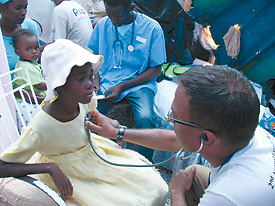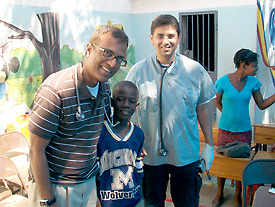Related story:
U-M Health System medical team returns from Haiti >
Dr. Hari Conjeevaram volunteered in Sri Lanka after the 2004 Indian Ocean tsunami and in Mississippi after Hurricane Katrina because he finds it necessary and spiritually uplifting to help in the wake of tragedies.
But the associate professor of internal medicine in the Medical School found his Jan. 29-Feb. 10 volunteer experience particularly moving. He calls the experience working in the aftermath of the Haiti earthquake “Faith, Hope and Love in the Rubble.”

Dr. Hari Conjeevaram, associate professor of internal medicine, examines a child during his recent medical mission to aid victims of the Haiti earthquake. Photo courtesy Dr. Hari Conjeevaram.
“It’s the way the people of Haiti live. There were several times I was awakened by songs in the middle of the night. One cannot but hear the songs of the heart people are singing at any given time when they get together to comfort themselves,” he says.
And despite the death and devastation, on Sunday mornings he would see people dressed their best as they walked to attend mass. “It just lifts you up every day and no matter how hard you work doing your service, it teaches us that faith, hope and love are the most important things we need,” he says.
Conjeevaram’s Haitian relief service was coordinated through the Sri Sathya Sai Organization. He joined a group of nine people from the United States and Canada that worked with two teams from Latin America. The organization promotes weekly medical volunteer trips to Haiti as long as there is need, Conjeevaram says.
The group was sent to Port-au-Prince, Haiti’s capital. He says that in contrast with the conventional image of the tropics as lush, Haiti is arid and mountainous, but still beautiful.
“Amidst the destruction due to the earthquake, with thousands living in tents and having lost most if not all of what they had, the striking thing one sees first and remembers the most is the beauty of the people, the smiles on their faces hiding their emotions, and most of all the faith they have in God,” Conjeevaram says.

Conjeevaram came across this young patient whose shirt reminded him of home. At right is Dr. Aroon Yusuf, a Canadian plastic surgeon. To learn more about U-M’s response to the disaster in Haiti, go to www.vpcomm.umich.edu/issues/haiti.html. Photo courtesy Dr. Hari Conjeevaram.
In two community churches, he and fellow volunteers saw 250-350 patients per day with both acute and chronic conditions. They also provided medical help to people in a nearby tent city. “Most people have lost everything after the earthquake including their medications … and we have been providing ongoing medical care with provision of medicines that they need,” Conjeevaram says.
The volunteers also set up medical camps in needy areas, as transportation disruption makes it hard for many to reach hospitals. His volunteer group also is aiding food distribution, provision of tents and home supplies to families, and a program for orphaned children.
The volunteers also provided medical help in the local government hospital in Port-au-Prince with specialties such as anesthesiology, orthopedics and vascular surgery, and in an acute trauma care center in the city with specialties such as plastic surgery.
In one instance, Conjeevaram helped U.S. Army personnel treat a woman who had not eaten for three or four days and was very weak.
“She ate the food I gave her in a matter of seconds, and when I went back to check on her after a few hours she was already feeling better and very appreciative for the help. She also told us that she was with a family of five, including her grandchildren, who have also been starving without much food for several days. We were able to request our local Sai center members to provide food packets to this family.”
While Conjeevaram says the country’s recovery is slow, there are positive signs.
“One starts seeing more activities on the streets … the fruit and vegetable vendors on the streets, roadside small stands and shops selling bread and other snack foods, boutique stores displaying colorful clothes, etc. These are not necessarily signs of a return of the economy but more an effort to return to the pattern of life the people are used to,” he says.

